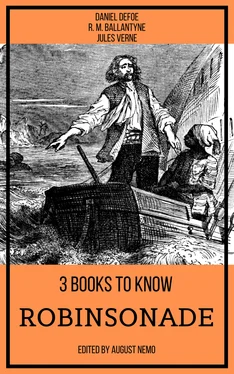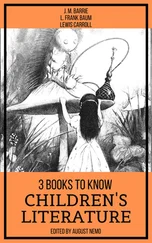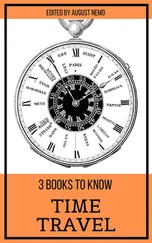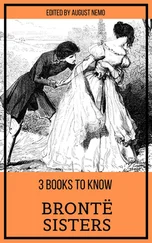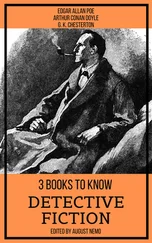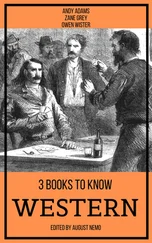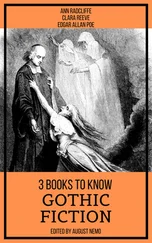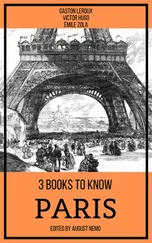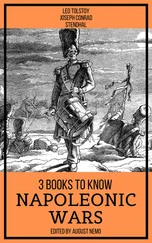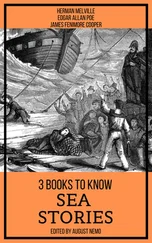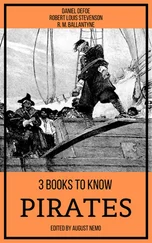We now resumed our journey, resolving that, in our future excursions into the interior, we would be careful to avoid this dangerous precipice.
Soon afterwards we arrived at the foot of the hill, and prepared to ascend it. Here Jack made a discovery which caused us all very great joy. This was a tree of a remarkably beautiful appearance, which Jack confidently declared to be the celebrated bread-fruit tree.
“Is it celebrated?” inquired Peterkin with a look of great simplicity.
“It is,” replied Jack.
“That’s odd, now,” rejoined Peterkin; “I never heard of it before.”
“Then it’s not so celebrated as I thought it was,” returned Jack, quietly squeezing Peterkin’s hat over his eyes; “but listen, you ignorant boobie! and hear of it now.”
Peterkin readjusted his hat, and was soon listening with as much interest as myself while Jack told us that this tree is one of the most valuable in the islands of the south; that it bears two, sometimes three, crops of fruit in the year; that the fruit is very like wheaten bread in appearance, and that it constitutes the principal food of many of the islanders.
“So,” said Peterkin, “we seem to have everything ready prepared to our hands in this wonderful island — lemonade ready bottled in nuts, and loaf-bread growing on the trees!”
Peterkin, as usual, was jesting; nevertheless, it is a curious fact that he spoke almost the literal truth.
“Moreover,” continued Jack, “the bread-fruit tree affords a capital gum, which serves the natives for pitching their canoes; the bark of the young branches is made by them into cloth; and of the wood, which is durable and of a good colour, they build their houses. So you see, lads, that we have no lack of material here to make us comfortable, if we are only clever enough to use it.”
“But are you sure that that’s it?” asked Peterkin.
“Quite sure,” replied Jack; “for I was particularly interested in the account I once read of it, and I remember the description well. I am sorry, however that I have forgotten the descriptions of many other trees which I am sure we have seen today, if we could but recognise them. So you see, Peterkin, I’m not up to everything yet.”
“Never mind, Jack,” said Peterkin with a grave, patronising expression of countenance, patting his tall companion on the shoulder —“never mind, Jack; you know a good deal for your age. You’re a clever boy, sir — a promising young man; and if you only go on as you have begun, sir, you will —”
The end of this speech was suddenly cut short by Jack tripping up Peterkin’s heels and tumbling him into a mass of thick shrubs, where, finding himself comfortable, he lay still, basking in the sunshine, while Jack and I examined the bread-fruit tree.
We were much struck with the deep, rich green colour of its broad leaves, which were twelve or eighteen inches long, deeply indented, and of a glossy smoothness, like the laurel. The fruit, with which it was loaded, was nearly round, and appeared to be about six inches in diameter, with a rough rind, marked with lozenge-shaped divisions. It was of various colours, from light pea-green to brown and rich yellow. Jack said that the yellow was the ripe fruit. We afterwards found that most of the fruit-trees on the island were evergreens, and that we might, when we wished, pluck the blossom and the ripe fruit from the same tree. Such a wonderful difference from the trees of our own country surprised us not a little. The bark of the tree was rough and light-coloured; the trunk was about two feet in diameter, and it appeared to be twenty feet high, being quite destitute of branches up to that height, where it branched off into a beautiful and umbrageous head. We noticed that the fruit hung in clusters of twos and threes on the branches; but as we were anxious to get to the top of the hill, we refrained from attempting to pluck any at that time.
Our hearts were now very much cheered by our good fortune, and it was with light and active steps that we clambered up the steep sides of the hill. On reaching the summit a new, and if possible a grander, prospect met our gaze. We found that this was not the highest part of the island, but that another hill lay beyond, with a wide valley between it and the one on which we stood. This valley, like the first, was also full of rich trees — some dark and some light green, some heavy and thick in foliage, and others light, feathery, and graceful, while the beautiful blossoms on many of them threw a sort of rainbow tint over all, and gave to the valley the appearance of a garden of flowers. Among these we recognised many of the bread-fruit trees, laden with yellow fruit, and also a great many cocoa-nut palms. After gazing our fill we pushed down the hillside, crossed the valley, and soon began to ascend the second mountain. It was clothed with trees nearly to the top; but the summit was bare, and in some places broken.
While on our way up we came to an object which filled us with much interest. This was the stump of a tree that had evidently been cut down with an axe! So, then, we were not the first who had viewed this beautiful isle. The hand of man had been at work there before us. It now began to recur to us again that perhaps the island was inhabited, although we had not seen any traces of man until now. But a second glance at the stump convinced us that we had not more reason to think so now than formerly; for the surface of the wood was quite decayed and partly covered with fungus and green matter, so that it must have been cut many years ago.
“Perhaps,” said Peterkin, “some ship or other has touched here long ago for wood, and only taken one tree.”
We did not think this likely, however, because, in such circumstances, the crew of a ship would cut wood of small size and near the shore; whereas this was a large tree, and stood near the top of the mountain. In fact, it was the highest large tree on the mountain, all above it being wood of very recent growth.
“I can’t understand it,” said Jack, scratching the surface of the stump with his axe. “I can only suppose that the savages have been here and cut it for some purpose known only to themselves. But, hallo! what have we here?”
As he spoke Jack began carefully to scrape away the moss and fungus from the stump, and soon laid bare three distinct traces of marks, as if some inscription or initials had been cut thereon. But although the traces were distinct, beyond all doubt, the exact form of the letters could not be made out. Jack thought they looked like JS, but we could not be certain. They had apparently been carelessly cut, and long exposure to the weather had so broken them up that we could not make out what they were. We were exceedingly perplexed at this discovery, and stayed a long time at the place conjecturing what these marks could have been, but without avail; so, as the day was advancing, we left it, and quickly reached the top of the mountain.
We found this to be the highest point of the island, and from it we saw our kingdom lying, as it were, like a map around us. As I have always thought it impossible to get a thing properly into one’s understanding without comprehending it, I shall beg the reader’s patience for a little while I describe our island, thus, shortly:
It consisted of two mountains: the one we guessed at five hundred feet; the other, on which we stood, at one thousand. Between these lay a rich, beautiful valley, as already said. This valley crossed the island from one end to the other, being high in the middle and sloping on each side towards the sea. The large mountain sloped, on the side farthest from where we had been wrecked, gradually towards the sea; but although, when viewed at a glance, it had thus a regular sloping appearance, a more careful observation showed that it was broken up into a multitude of very small vales — or, rather, dells and glens — intermingled with little rugged spots and small but abrupt precipices here and there, with rivulets tumbling over their edges and wandering down the slopes in little white streams, sometimes glistening among the broad leaves of the bread-fruit and cocoa-nut trees, or hiding altogether beneath the rich underwood. At the base of this mountain lay a narrow bright-green plain or meadow, which terminated abruptly at the shore. On the other side of the island, whence we had come, stood the smaller hill, at the foot of which diverged three valleys — one being that which we had ascended, with a smaller vale on each side of it, and separated from it by the two ridges before mentioned. In these smaller valleys there were no streams, but they were clothed with the same luxuriant vegetation.
Читать дальше
